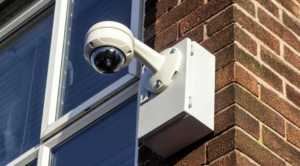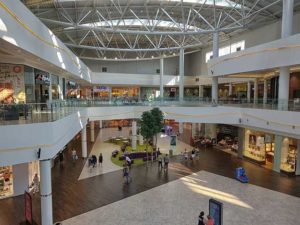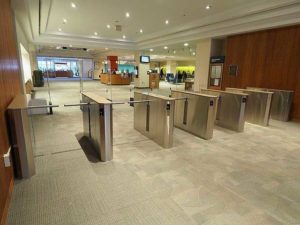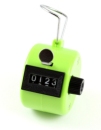Monitor - ISSN 1472-0221
The Newsletter for PC-Based Data Acquisition and Control
Issue 253, October 2019
Welcome to Monitor - thank you for subscribing. Any comments or questions email monitor@windmillsoft.com. For a full archive of back issues see windmill.co.uk/newsletter.html
You can download a pdf copy of this newsletter here.
Contents
* Seven Sensing Technologies to Measure Footfall
* Your DAQ Questions Answered: Comparator Communications
* Data Acquisition News Round-Up
Seven Sensing Technologies to Measure Footfall
Web link: https://www.windmill.co.uk/footfall-technology.html
Footfall is the count of the number of people entering an area, shop or building in a given time. How to measure footfall? We compare the positives and negatives for seven footfall measurement technologies.
Video Counting - Wi-Fi Mobile Probes - Wi-Fi Signal Strength - Mobile App - Thermal Sensors - Infra-Red Beam - Turnstiles - Manual
Video Footfall Counting
In video footfall counting, an overhead IP or CCTV camera tracks people's movements. The camera connects to a people counter which accurately detects and records how many people pass through the counting zone. The people counters send back data to a central database or make the information available to the Internet-of-Things.
Advantages
- One of the most accurate methods at 98%.
- Easy to verify remotely that the counting system is working correctly.
- System can be scaled up to include other areas
- Privacy – people are not identified
- Counts can be integrated with POS systems in real-time
- Can measure dwell time and occupancy
- Can generate heat maps of popular areas
- Handles wide entrances and outdoor counting
- Can be adjusted via software for individual situations – crowds, reflections, etc.

Disadvantages
- Installation takes longer than for simpler systems like beam counters.
Smartphone Counting - Wi-Fi Probe Requests
There are several ways to count people using mobile signals. One is to collect Wi-Fi probe request signals from shoppers’ smartphones.
Advantages
- Can record returning customers.
- Can count inside and outside.
- Can measure dwell times.
- Can track people and generate heat maps of popular areas.

Shopping centres use video footfall counting
Disadvantages
- Privacy concerns - the ethical and data protection considerations of knowing exactly how often a person returns to a location and where they went. Data collection and processing to track and understand shoppers' behaviour likely qualifies as personal data and will come under data protection regulations.
- Only counts those carrying a smart phone with Wi-Fi switched on.
App Counting on Mobile Phones
An opt-in mobile app communicates when it is approaching and inside a store.
Advantages
- Can record returning customers.
- Can count inside and outside a store.
- Can track people to generate heat maps of popular areas.
- As it is opt-in, privacy concerns are reduced.
- Wide entrances and outdoor counting covered.
Disadvantages
- Data is only collected from those who have installed the app hence not an accurate method of measuring footfall.
Counting using Wi-Fi Patterns and Signal Strengths
Uses the received signal strength of a Wi-Fi link to estimate the number of people in the area of interest, without requiring them to carry any device like a mobile phone. The strength of the signal is first measured in the absence of people for comparison.
Advantages
- No privacy issues.
- 98% accurate.
- Will work through walls.
Disadvantages
- Can only provide counts, not, for example, dwell times and heat maps.
- Provides occupancy counts, not entries and exits.
- Can’t verify counts without using an independent method.
- As yet are mainly experimental systems.
Thermal Sensors
Positioned above an entrance, thermal sensors identify people by measuring their body heat.
Advantages
- Quoted accuracies are between 96 and 98%.
- Privacy – people are not identified .
- Network together for wide areas.
Disadvantages
- Accuracy can be affected by the ambient temperature within the counting area being above or below a certain value. Low ceilings can also reduce the accuracy.
- Have difficulty measuring the dwell time of people.
- Needs a camera or other method to verify counts.
Infra-Red Beam Systems
A sensor sends a beam to a reflector on the opposite side of the doorway. When someone passes through, the beam breaks and a person is counted. These were popular twenty years ago – now higher accuracy and more information is generally needed for most applications.
Advantages
- Privacy – people are not identified.
- Low cost.
- Easy to install.
- Can communicate with a server in real-time.
Disadvantages
- Accuracy tends to decrease with wide or busy entrances. Direct sunlight onto the beam will also affect the system. Difficult conditions can bring accuracy down to 80%.
- Don’t measure dwell time or provide heat map data.
- Needs a camera or other method to verify counts.
Turnstile
A turnstile is a kind of gate which lets one person in at a time. They provide an accurate count of entries, which is why our video people counting product is called “Video Turnstile”. Drop Arm Optical Turnstiles are beam counters which raise a mechanical arm to let people through.

Drop arm optical turnstile by Fabtron CC BY-SA 4.0
Advantages
- Extremely accurate.
- Good where security is needed.
Disadvantages
- Not suitable for shops and areas where easy access is needed.
- Dwell times and heat maps not available.
Manual Counts

Hand-held tally counters are the least sophisticated of solutions. A person stands clicking the tally counter (or a tally counter app on a mobile phone) whenever anyone passes through the entrance. This may be acceptable for a one-off people counting exercise, but is obviously unsuited to continuous monitoring. Tally counters were once used in nightclubs and bars to monitor occupancy, but have now been replaced by automatic counting systems.

Tally Counter App can be
used for manual footfall counts
Advantages
- Cheap if done on a small-scale for a short time.
Disadvantages
- Accuracy varies depending on number of people entering and the person doing the counting
- Verification of counts not possible unless another method is also used.
- Labour-intensive.
- Can’t be automatically integrated with POS system
References and More Information
How a CCTV, or IP Camera, People Counting System Works, Retail Sensing. Accessed 17 October 2019
Osama T. Ibrahim, Walid Gomaa, Moustafa Youssef, CrossCount: A Deep Learning System for Device-free Human Counting using Wi-Fi. IEEE Published: 2019
Web learning resources for the EU General Data Protection Regulation- Accessed 20 September 2019
Disclaimer: Windmill Software have been involved in creating the software used by Retail Sensing to count footfall. For more details e-mail sales@biodataltd.com.
Your Data Acquisition Questions Answered: Comparator Communications
Web link: https://www.windmill.co.uk/parse.html
Question
I have been trying to get a comparator (Heidenhain ND1200 Quadra-Chek) to communicate with a computer. I'm completely new to this, and if all I can do is get the data to output into something I can port to Excel, I'll be happy. Right now I'm not sure how to parse the data because the sections of data are broken up by "009" characters.
Do you have any advice on this?
Thanks immensely (because even if you can't help with this issue - your website/program has been quite helpful already)
Answer
009 is the decimal code for a tab character. In the ComDebug Parser window, select the Search action. Now choose the NonPrint menu and select NonPrint Decimal. Enter 009 as the decimal. This will find the first tab character. Next select Extract Until and choose to extract everything until the next 009 tab character (use the NonPrint Decimal option again). This will save all the data between the two tab characters.

Any character shown in the Char column as 3 digits is a "non-printing decimal". In this case 009 is a tab character
You can download the ComDebug software from https://www.windmill.co.uk/serial.html
DAQ News Round-up
Welcome to our round-up of the data acquisition and control news. If you would like to receive more timely DAQ news updates then follow us on Twitter - @DataAcquisition - or grab our rss feed.
Protecting smart machines from smart attacks
Machines' ability to learn by processing data gleaned from sensors underlies a host of emerging technologies. But that learning ability leaves systems vulnerable to hackers in unexpected ways.
Source: Princeton University
https://www.princeton.edu/
How many trees are there on Earth? Mission to measure planet's biomass
Trees are our biggest ally against climate change - but we've never been sure how big. New technology is revealing their potential for the first time
Source: New Scientist
https://www.newscientist.com/
Engineers solve 50-year-old puzzle in signal processing
The FFT algorithm was published in 1965. Four years later, researchers developed a more versatile, generalized version called the chirp z-transform (CZT). But a similar generalization of the inverse FFT algorithm has gone unsolved until now.
Source: Iowa State University
https://www.news.iastate.edu/
Portable device instantly analyses airborne hazards
Airborne hazards such as sulphur dioxide and benzene could be identified instantly and at a safe distance thanks to a portable device developed in Singapore.
Source: The Engineer
https://www.theengineer.co.uk/
Soil sounds show when ground under structures is deteriorating
Loughborough University is to develop new systems that can 'hear' when the soil under buildings is starting to degenerate.
Source: Loughborough University
https://www.lboro.ac.uk/
Developing sensors for worm robots to be used after disasters
In order to speed up the detection of survivors trapped in collapsed buildings and to improve working conditions for the first responders, a new Europe-wide project is devising novel technologies using drones, miniaturised robotic equipment and advanced sensors.
Source: Manchester University
https://www.manchester.ac.uk/
* Copyright Windmill Software Ltd
* Reprinting permitted with this notice included
* For more articles see https://www.windmill.co.uk/
We are happy for you to copy and distribute this
newsletter, and use extracts from it on your own web
site or other publication, providing the above notice
is included and a link back to our website is in place.
For previous issues by subject see https://www.windmill.co.uk/monitorindex.html
SUBSCRIBING OR CANCELLING SUBSCRIPTION Visit https://www.windmill.co.uk/newsletter.html and add or remove your e-mail address.
Windmill Software Ltd, PO Box 58, North District Office,
Manchester, M8 8QR, UK
Telephone: +44 (0)161 834 6688
Facsimile: +44 (0)161 833 2190
E-mail: monitor@windmillsoft.com
https://www.windmill.co.uk/
https://www.windmillsoft.com/
